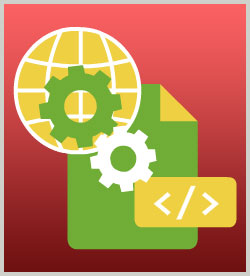IT Skills Web Development and Graphic Design Scripting JavaScript
Automating repetitive tasks in the web development process can greatly improve the efficiency of the development team and the overall quality of the final product. In this course, you'll learn how to use Gulp.js to assist you in your web development projects. Focus is centered on how Gulp.js can help you with web development and how to install it for use in the development environment. In addition, this course covers how to use Gulp.js plugins to assist you with JavaScript coding and CSS compilation.
| Objectives |
Introduction to Gulp - start the course
- describe what Gulp is and the benefits of using it in your development workflow
- describe the purpose of a build pipeline and Gulp streams
- identify the four Gulp APIs and describe the purpose of each
Preparing the Development Environment - install the appropriate package installer for Windows or Mac computers
- install and configure the Node.js node package manager (npm) for use in your projects
- install and configure the Git version control package for your projects
- use the npm package manager to install and configure Gulp and Bower globally for use in your projects
- use the npm package manager to install and configure packages locally for use in your projects
- identify the differences between dependencies and devDependencies and how to create them
- install and configure the Brackets text editor
- create a Hello World Gulpfile.js to demonstrate working with Gulp tasks
Using Gulp Plugins for JavaScript Analysis - describe the purpose of the JSHint and JSCS plugins for performing code analysis against JavaScript
- install and configure the Gulp JSHint and JSCS plugins for JavaScript linting and code style checking
- create code for JSHint and JSCS tasks in Gulp
- install and use the Gulp concat plugin to concatenate multiple files into one
- install individual Gulp plugins as well as use lazy loading to load all Gulp plugins
- install and use the Gulp uglify plugin to perform minification of your JavaScript code
- create and work with a reusable configuration file in Gulp
CSS Compilation in Gulp - install and use the Gulp SASS plugin to compile your CSS code
- install and work with the Gulp autoprefixer plugin to add vendor prefixes in your CSS code
- install and use the Gulp csslint plugin to locate problems in your CSS code
- install and use the Gulp uncss plugin to perform optimization of your CSS code
- install and use the Gulp csso plugin to remove all unnecessary characters from your CSS code
- work with the on error method in Gulp to perform error handling in your CSS code
- install and work with the gulp-plumber tool to perform error handling in your CSS code
Practice: Gulp and Gulp Plugins - identify the Gulp APIs and the main plugins used for working with JavaScript and CSS code
|


